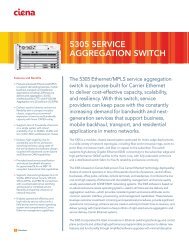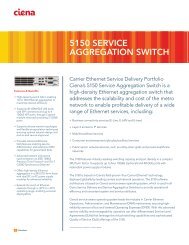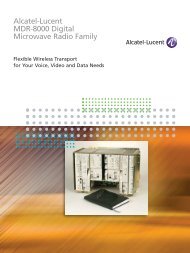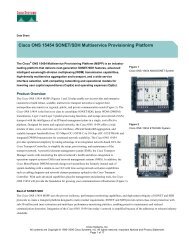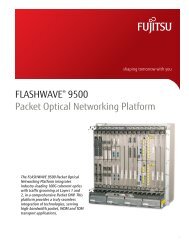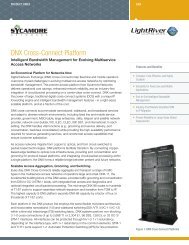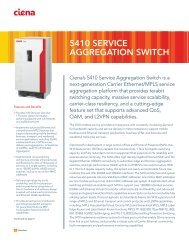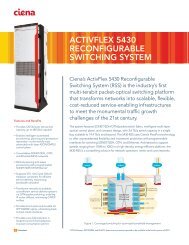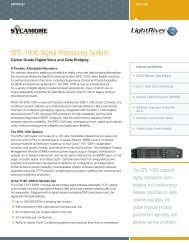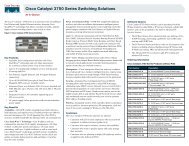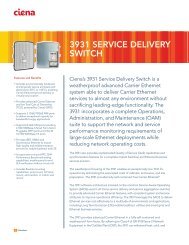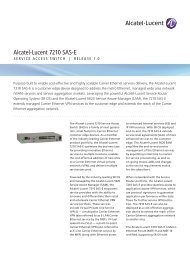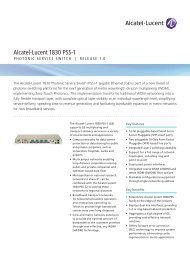Tropos 6320/6310 Mesh Router - Wireless Tech
Tropos 6320/6310 Mesh Router - Wireless Tech
Tropos 6320/6310 Mesh Router - Wireless Tech
Create successful ePaper yourself
Turn your PDF publications into a flip-book with our unique Google optimized e-Paper software.
<strong>Tropos</strong> <strong>Mesh</strong> OSThe <strong>Tropos</strong> <strong>Mesh</strong> OS is the cornerstone of the decentralized <strong>Tropos</strong>System Architecture. A common software platform that runs on eachrouter across the network, the <strong>Tropos</strong> <strong>Mesh</strong> OS leverages the router’son-board intelligence to monitor and maximize performance. Unlikecontroller-based architectures that suffer bandwidth losses as controltraffic is passed back and forth between network nodes and thecentral site, the distributed <strong>Tropos</strong> System Architecture uses efficienton-board processing at the device level to minimize network congestionand adapt on a real-time, packet-by-packet scale. This distributedapproach optimizes performance and throughput by minimizingcontrol traffic, delivers a highly scalable solution, and helps provide aquality user experience for network clients.PWRPThe cornerstone of the <strong>Tropos</strong> <strong>Mesh</strong> OS is the patented Predictive<strong>Wireless</strong> Routing Protocol (PWRP), which continually analyzesthe quality of active and inactive mesh links to dynamically configurethe ideal combination of paths to optimize network performance.Upon deployment, the routers automatically discover oneanother, and quickly determine the optimal route to the gatewaysthat inject capacity into the network. Optimal links are chosen onthe basis of throughput, packet success, signal-to-noise ratios, andother key criteria.PWRP performs a range of key tasks across the wireless network:v Streamlines deployments and preserves performance by dynamicallyconfiguring and optimizing mesh connectionsv Improves overall throughput by selecting optimal routing pathsv Enhances network resiliency by providing graceful rerouting oftraffic in the event of RF interference, backhaul failures, or otherdisruptions in the wireless meshv Supports client mobility without the need for special client hardware,software, or network reconfigurationsv Enables the network to be scaled to thousands of nodes coveringthe largest geographical areas in the industryPowerCurveA distributed algorithm that leverages the <strong>Tropos</strong> PWRP communicationprotocol, PowerCurve maximizes network performance andcapacity by automatically optimizing power and rate parameterson a per-connection and per-packet basis. This advanced, distributedalgorithm continually adjusts transmit power to maximizethe number of wireless links that can operate concurrently. Unlikealternative approaches where transmit power is configured as a staticsetting, PowerCurve tightly couples power and bit rate control. Thisenables the router to make continuous and dynamic adjustmentsthat can enhance throughput and provide a better user experience.PowerCurve delivers the following key benefits:v Dynamically monitors and adjusts power and rate per-packet,per-link, to deliver maximum capacityv Enhances network reliability, capacity, and scalability beyond thecapabilities of controller-based architecturesv Streamlines network planning, deployment, and optimizationAirtime Congestion ControlAirtime Congestion Control (ACC) technology enables networks to beoperated closer to their capacity limits by detecting signs of congestionand dynamically adjusting airtime resource allocation to clients. ACCis unlike traditional rate limiting in two important ways. First, insteadof limiting traffic during congestion-free periods, ACC activates onlywhen performance-impacting congestion is detected and returns toa monitoring state afterward. Second, it is mesh- and wireless-aware,distributing airtime resources equally among clients during a congestionevent rather than applying fixed throughput caps. By allowing networksto carry heavy traffic loads without crossing over into a saturated state,ACC actually increases usable capacity.v Deterministic allocation of airtime resources enables networks torun at higher capacity without congestionv Monitors airtime availability to deliver more efficient networkutilization than systems relying on limiting traffic levelsv Provides fair network access to all users, enabling <strong>Tropos</strong> tosurpass traditional broadband wireless network capacity



